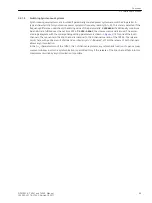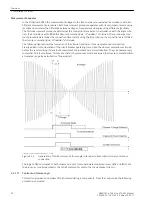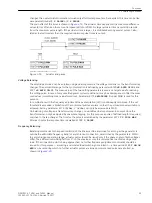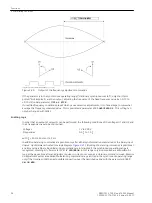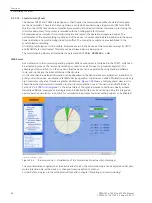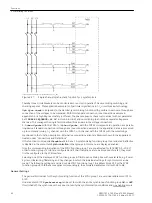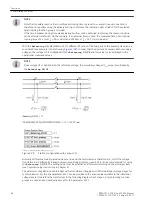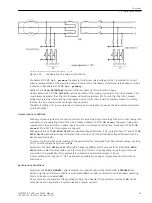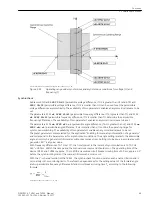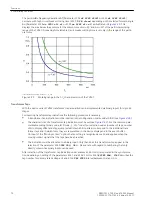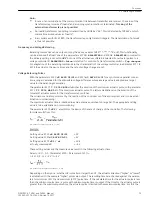
Address 6102
SyncSD
is used to select the switchgear component to which the synchronizing settings are to
be applied. If the option
none
is selected the function can be used as an external synchronizing feature. It will
then be triggered via binary input messages. This corresponds to standard use as a parallel device.
Parameters 6103
Umin
and 6104
Umax
set the upper and lower limits for the operating voltage range for U1
or U2 and thus determine the operating range for the synchronizing function. If the values leave this band, a
message will be output. A typical setting is approx. ±10 % of rated voltage.
Address 6105
U<
indicates the voltage threshold below which the feeder or the busbar can safely be consid-
ered switched off (for checking a de-energized feeder or busbar). For this a preset value of approx. 5 % rated
voltage was selected.
Address 6106
U>
indicates the voltage threshold above which the feeder or busbar can safely be considered
energized (for checking an energized feeder or busbar). It must be set below the minimal anticipated opera-
tional undervoltage. For this reason a setting value of approx. 80 % rated voltage is recommended.
The setting for the mentioned voltage values is made in secondary volts.
Addresses 6107 to 6109 are set to specify the enabling conditions for the closing check. The following
addresses mean:
6107
SYNC U1<U2>
= Component U1 must be de-energized, component U2 must be energized (connection
to reference without voltage, dead bus);
6108
SYNC U1>U2<
= Component U1 must be energized, component U2 must be de-energized (connection
to feeder without voltage, dead line);
6109
SYNC U1<U2<
= Power supply unit U1 and U2 must both be dead (connection with dead reference and
dead feeder, Dead Bus/Dead Line);
These possible enabling conditions are independent of each other and can also be combined.
For safety reasons enablings are switched off in the presetting and are thus set to
NO
.
Parameter
TSUP VOLTAGE
(address 6111) can be set to configure a monitoring time which requires above
stated release conditions to be present for at least de-energized switching before switching is allowed. The
preset value of
0.1
considers transient responses and can be applied without modification.
Enabling via synchronous check can be limited to a configurable synchronous monitoring time
T-SYN.
DURATION
(address 6112). The configured conditions must be fulfilled within this time. Otherwise release is
not granted and the synchronizing function is stopped. If this time is set to ∞, the conditions will be checked
until they are fulfilled. This is also the preset value. On establishing a time limit operational conditions must be
observed. They must be established in accordance with each system.
With parameter 6113
PHASE SEQUENCE
you can disable the phase sequence check for the U1 and U2
voltages together or enable them together for clockwise rotation (
L1 L2 L3
) or anticlockwise rotation (
L1
L3 L2
). This parameter is not displayed for single-phase synchronization check.
With enabled phase sequence check this voltage input (Uc; Uf) is referred to additionally to detect a discon-
nected or energized line or busbar (see also subsection „Switch to dead busbar/dead line“ in the function
description of the synchronizing function).
Power System Data
The power system data for the synchronizing function are set at addresses 6120 to 6127.
The circuit breaker closing time
T-CB close
at address 6120 is required if the device is to close also under
asynchronous system conditions. The device will then calculate the time for the close command such that the
voltages are in phase in the instant the breaker poles make contact. Please note that this should include the
operating time of the breaker as well as the operating time of an auxiliary relay that may be connected in the
closing circuit. You can determined the breaker operating time by means of the 7VE61 and 7VE63 (see
commissioning notes in Chapter 3).
Functions
2.2 Paralleling Functions
SIPROTEC 4, 7VE61 and 7VE63, Manual
63
C53000-G1176-C163-3, Edition 10.2017
Summary of Contents for SIPROTEC 4 7VE61
Page 8: ...8 SIPROTEC 4 7VE61 and 7VE63 Manual C53000 G1176 C163 3 Edition 10 2017 ...
Page 24: ...24 SIPROTEC 4 7VE61 and 7VE63 Manual C53000 G1176 C163 3 Edition 10 2017 ...
Page 142: ...142 SIPROTEC 4 7VE61 and 7VE63 Manual C53000 G1176 C163 3 Edition 10 2017 ...
Page 192: ...192 SIPROTEC 4 7VE61 and 7VE63 Manual C53000 G1176 C163 3 Edition 10 2017 ...
Page 222: ...222 SIPROTEC 4 7VE61 and 7VE63 Manual C53000 G1176 C163 3 Edition 10 2017 ...
Page 230: ...230 SIPROTEC 4 7VE61 and 7VE63 Manual C53000 G1176 C163 3 Edition 10 2017 ...
Page 256: ...256 SIPROTEC 4 7VE61 and 7VE63 Manual C53000 G1176 C163 3 Edition 10 2017 ...
Page 314: ...314 SIPROTEC 4 7VE61 and 7VE63 Manual C53000 G1176 C163 3 Edition 10 2017 ...
Page 316: ...316 SIPROTEC 4 7VE61 and 7VE63 Manual C53000 G1176 C163 3 Edition 10 2017 ...
Page 330: ...330 SIPROTEC 4 7VE61 and 7VE63 Manual C53000 G1176 C163 3 Edition 10 2017 ...

